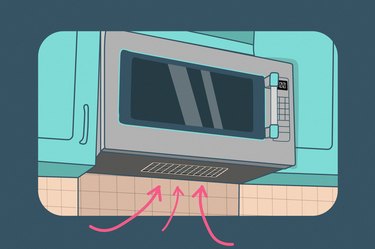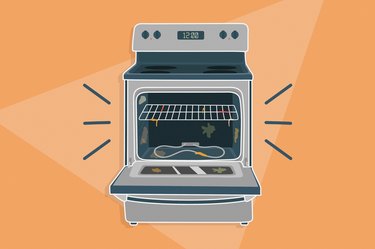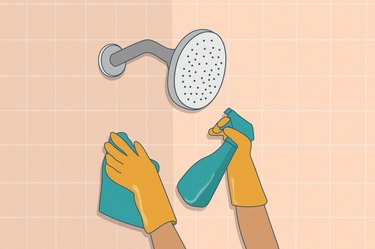
Psst. Hey! Did you know that many microwaves have filters on them? And that they're supposed to be cleaned and/or replaced on the regular?!
Yup, file this under another one of those home maintenance facts that most of us have no idea about...but that actually should be taken care of pretty frequently.
Video of the Day
Video of the Day
Most over-the-range microwaves contain a grease filter, a charcoal filter or both. "Grease and charcoal filters are great for cleaning and then recirculating air inside the microwave, as opposed to venting the air outside of the appliance. This helps avoid a buildup of grease and odors," explains Leanne Stapf, COO of The Cleaning Authority.
And in order to keep your microwave — and the air in your kitchen! — clean, regularly cleaning and replacing those filters is a must. Here's everything you never thought you needed to know about these two microwave parts that you had no idea existed. Plus, what happens if you just keep on ignoring them.
The Grease Filter
Underneath your microwave is a rectangular silver plate with lots of tiny grates. Go ahead and take a look! That's your microwave's grease filter, and it's pretty important.
"The purpose of grease filters is to help catch grease that splatters up from your stovetop before it reaches the exhaust fan," says Lindsay Jones, new product brand manager for Maytag.
Catching all that gunk can help keep nasty, smelly air laden with food particles from circulating around your kitchen when you run the microwave. So, y'know, your bowl of popcorn smells fresh and buttery instead of like old food.
What Happens When You Don't Clean It?
Once a grease filter gets clogged up, it stops being effective. "If a grease filter isn't cleaned frequently enough, grease and leftover food odors will continue to accumulate [around the filter], creating a dirty atmosphere," Stapf says.
In other words, you'll get oil bits and food gunk floating around in the air. No, you won't be able to see them. But you might smell an off odor when you run the microwave, and of course, you'll be breathing the stuff in. Gross.
How Often to Clean Your Microwave's Grease Filter
Grease filters do best with a seasonal scrub. "As a general rule of thumb, you should clean your grease filter at least every three months," Jones says.
It's worth checking the manufacturer instructions for your microwave, though. Whirlpool, for instance, suggests cleaning the grease filter once a month, while GE Appliances says you can get by with a cleaning every six months.
How to Clean It
De-gunking your grease filter might be pretty gross the first time around, but once you're keeping up with the cleaning regularly, it probably won't be a herculean task. Here's how to do it:
- Start by unplugging your microwave and popping the grease filter out from the bottom of the unit. (This video gives a good visual for how to do that, but it's worth checking your microwave's instructions too.)
- Place the filter in a large bowl or the sink, sprinkle it with 1/4 cup of baking soda and submerge the filter fully in warm water, Stapf recommends.
- Let the filter soak for a few minutes to give the grease some time to dislodge, then get in there with a cleaning brush or sponge and some mild dish soap to scrub away the gunk. (Avoid putting grease filters in the dishwasher, says Stapf.)
- Allow the filter to dry fully and reinsert in the microwave.
- Set a reminder on your calendar to clean it again in three months.
The Charcoal Filter
Your microwave's charcoal filter looks a lot like the grease filter, but it's tucked inside your microwave, typically behind the vented panel that sits on top of the microwave door. Even if you've never taken a single look at it, it plays a worthy role in your kitchen.
"Charcoal filters absorb unwanted odors in the air while cooking, made possible by the pores on the charcoal's surface," Jones says. "Especially for microwaves that recirculate into the home, the charcoal filter is key to helping get rid of leftover smells after cooking odorous foods."
What Happens When You Don't Clean It?
A charcoal filter that's plugged up with gunk can't keep absorbing odors, which means you might start to notice a funky or unpleasant smell in your kitchen while the microwave is running, say Jones and Stapf.
That's not all: A too-dirty charcoal filter forces your microwave to work harder when it's heating food, Shapf notes, because extra grease and gunk can end up in your microwave's exhaust. And the added strain can shorten the life of your unit.
How Often to Replace Your Microwave's Charcoal Filter
Charcoal filters typically need to be replaced (as in, buy a new one — don't clean the old one) every six months, Jones says.
If you want to try to get by with doing it less often, check the filter to see how much build-up is on it. If the surface of your filter appears totally shiny and filled with grease, that's a sign that it's hit max capacity and needs to be replaced, according to GE Appliances.
How to Replace It
Replacing your microwave's charcoal filter is another relatively easy task. You'll just need to make sure you have a few tools handy and the right replacement filter.
- First, buy a new replacement filter. The filters are model-specific, so make sure you have your microwave's make and model handy before shopping. "You can find replacement filters at any home improvement store or on your microwave manufacturer's website," Jones says.
- Use a Phillips head screwdriver to unscrew and remove the top vented panel of your microwave and set aside. (Put the screws in a safe place so they don't get lost!)
- Remove the charcoal filter. It's usually in the middle of the area behind your vented panel, but if you're not sure, check your microwave's instruction manual. (This video also has a good visual, if you need more clues.)
- Dispose of the old charcoal filter. These can typically be tossed in with the regular trash, per Miele, but it never hurts to check with your local sanitation department if you're unsure.
- Pop in the new charcoal filter. Again, your manufacturer's instructions may have some helpful hints on the best way to do this for your microwave, so take a look.
- Put the vent panel into place, put the screws back in and tighten with the screwdriver.
- Set a reminder on your calendar to order a new charcoal filter in six months.
The Bottom Line
Gunked-up microwave filters aren't typically a life-or-death situation. But going too long without cleaning or replacing them can cause grease and odors to build up in the appliance, which can smell funky and possibly shorten the lifespan of your microwave, says Stapf.
Plus? The longer you go without cleaning your filters, the more tedious the job will be when you finally do it. "After years of buildup, filters can get more difficult to clean," Jones says.
- Whirlpool: "Microwave filter cleaning: how-to guide"
- GE Appliances: "VENT HOOD - CLEANING METAL GREASE FILTERS"
- GE Appliances: "OVER-THE-RANGE MICROWAVE - CHARCOAL FILTER REPLACEMENT"
- Manuals Lib: "Charcoal Filter; Disposing Of The Charcoal Filter - Miele DA 396-6 Operating And Installation Instructions"
Is this an emergency? If you are experiencing serious medical symptoms, please see the National Library of Medicine’s list of signs you need emergency medical attention or call 911.



